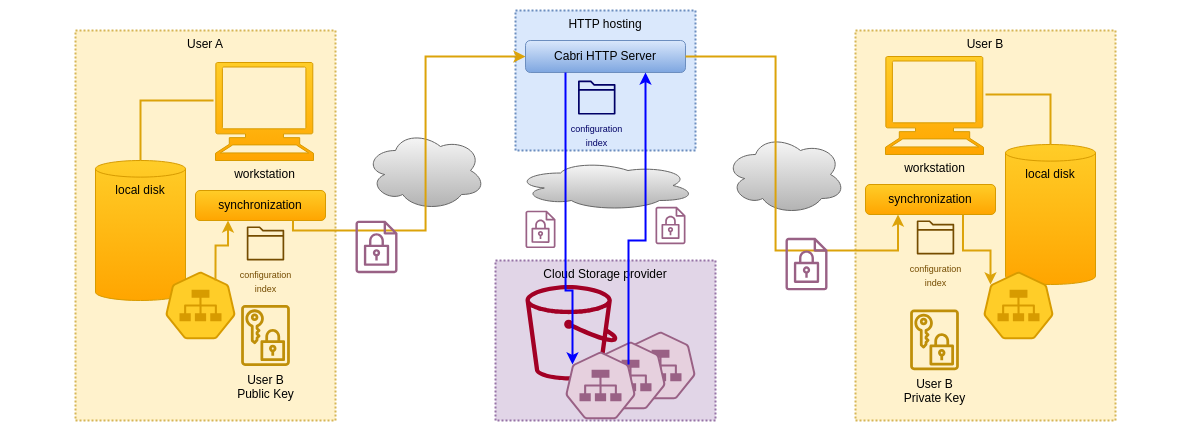Using Cabri to share data with confidence
Published on 2023/08/22
Cabri is a free and open source tool designed specifically to store data on various media, synchronize data sets one with the other, between different places, with the people you want.
It is both fast and secure, providing confidentiality in untrusted environments.
It is mainly available as a command-line tool, but also provides an API (Golang and REST). A GUI is under development. Cabri is currently in beta release.
This short article presents the main types of usage.
Backup files on external drive
Cabri manages what it calls Data Storage Systems (DSS). A DSS is a collection of data files along with their properties: name and related location, size, last modification time, checksum and access rights. Cabri also can deal with files and subdirectories under a local directory as a DSS. As Cabri provides a synchronization tool, local directory's content can be backed up on a DSS located on an external drive to be restored whenever needed.

Most operating systems for sure already do it very well. What Cabri adds in that case is:
- managing data files checksums to detect possible data corruption
- incremental storage: successive synchronizations don't erase previous content but only add new content or hide removed content, anyway the full history is available until parts of it are explicitly deleted
- deduplication: same content copied several times in a DSS is only stored once
- operating system neutrality: if the external drive partitioning is portable, FAT for instance, then the Cabri DSS can be restored on any OS where Cabri is available
Backup files on Cloud Storage
Cabri also manages DSS that store their data using Cloud Storage: any Cloud Storage compatible with Amazon S3 can be used, mainly Openstack Swift containers and Amazon S3 buckets. Extending the previous example, a local directory's content can be backed up in the cloud and restored from it.

Same benefits occur as with an external drive DSS: checksums, incremental storage and deduplication. But the first benefit is that backed up data's availability is much better, because it is physically stored elsewhere, not talking about Cloud services themselves.
Share files between users or locations
Is the backed up data available from anywhere? This is almost true but the DSS still must be declared locally: this local configuration is needed to describe how to connect to the Cloud Storage service, and it also stores an index of the DSS, which is required to provide fast access to its content.
While this local configuration could be copied from place to place to access shared content, this is error prone and not very practical. What is needed is remote access to the corresponding information. Cabri comes with a HTTP server that can be hosted on the internet to provide access in this case to the Cloud Storage DSS.

The HTTP server is instructed to give access to one or several DSS at specific URLs. The Cabri clients at different locations can keep their view of the shared content up-to-date thanks to this shared service, and share new content with other users or from other locations.
Note that the HTTP server could provide access to a DSS implemented as files local to the server as well, there is nothing specific to Cloud Storage in such a configuration.
Encrypting sensitive data
Local data or data stored on external drive may be at risk if the device is lost or stolen. Data stored with Cloud Services may be at risk if some operator get unauthorized access to it. For these reasons and many others, sensitive data must be encrypted.
Many operating systems enable encrypting data, generally relying on full-disk encryption: you can only read a disk's content if you are authenticated or provide a correct passphrase.
Similarly, some Cloud Storage services come with encryption features, the most easy to use being a secret managed by the Cloud provider for encrypting a full data set.
Cabri also enables data encryption. As Cabri is a Data Storage System, encryption works at the data level.

Encryption keys are fully under the control of the users, and the data is only decrypted once retrieved as local files when the user has provided a relevant key.
Share sensitive data with public key encryption
When an encrypted Cabri DSS is shared by several users, each user owns his or her personal secret to decrypt the data. Cabri uses public-key encryption: data producers encrypt data with other users' public keys, data consumers owning the corresponding private keys can decrypt the data. No secret need to be shared among users, and distinct data sets can be made visible to different sets of users.

During the interaction illustrated above, User A only needs to know the public key of User B to encrypt some data for him or her. Only User B owns the corresponding private key to be able to decrypt the corresponding data.
In case you're interested, the underlying technology is age, see reference at the page bottom for more information.
One very important property here is that the remotely shared hosted service, and as seen above, the whole data set on Cloud Storage, are fully encrypted, the decryption being only available to the users owning the private keys on their client local positions. So even in case of any security breach occuring on hosted services, no confidential data is never exposed.
Data engineering API
All DSS data access services are available through a simple local REST API, in complement to the native golang API.
That means that data engineering and data science pipelines can easily store, protect, share and retrieve data, whenever it is stored on local drives, Network or Cloud Storage, encrypted or not, at any time back in the history.

In addition, synchronization services can extract data sets from one DSS to another for convenience.
Conclusion
From personal data backup to data pipelines storage, through multi-user data sharing in the cloud, encrypted or not, Cabri supports many data storage use cases, some of them you may want to implement. You can evaluate if it is relevant in your case by getting started using it while reading its documentation, as referenced below.
References
- Cabri project and documentation
- age - A simple, modern and secure encryption tool

